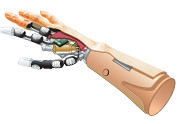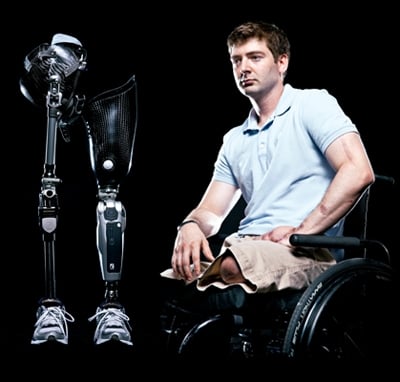
Photographs by Chris Leaman
DAN BERSCHINSKI
After losing both legs in Afghanistan, he's learning to walk on power knees
✯ ✯ ✯ ✯
US Army captain Dan Berschinski moves unsteadily. He feels as if he’s standing on stilts—even though he’s shorter on his titanium legs than he was on his natural legs.
A harness around his midsection tethers him to a metal track on the ceiling. This stops him from falling as he makes his way around the physical-therapy room at DC’s Walter Reed Army Medical Center.
Sweat pours down Captain Berschinski’s face as he moves step by step, trying to figure out how to use these newest-generation prostheses. He stops every few steps while technicians make adjustments to his bionic legs to improve his gait and balance. A nurse follows along and mops his brow.
“It takes more effort to take one step now than it took to take ten steps with my own legs,” Berschinski says.
He is wearing two “power knees,” a technological marvel developed by Össur, an Icelandic prosthetics company. Power knees is a misnomer for Berschinski, who has prosthetic legs—he lost both of his own when he stepped on an improvised explosive device (IED) in Afghanistan. Of the more than 55,000 deaths and casualties in nine years of combat in Iraq and Afghanistan, 1,200-plus US servicemembers have suffered limb amputations.
Each of Berschinski’s prosthetic legs costs about $40,000—when the prosthesis was developed in 2006, it was almost $100,000—and comes equipped with microprocessors and a battery-driven motor, good for 12 hours, that bends and straightens the knee.
Berschinski’s right leg was blown off at the hip. Surgeons removed what remained of his shattered femur, the big bone from the hip to the knee, and gave him a carbon-fiber socket that allows the prosthetic leg to be attached. His left leg was ripped off above the knee, leaving enough leg for a prosthesis to be attached.
On this day, Berschinski keeps walking around the therapy room trying to master the use of the new prosthetics; doing so might allow him to walk with a powered gait, whereby microprocessors respond to his movement and prompt his prosthesis to take a forward step. The artificial intelligence built into the bionic device can sense when he’s walking downhill or up and make adjustments.
The legs move independent of one another; each has its own sensors so it knows where it is in the step cycle. But fine-tuning is needed; sometimes the legs move too far forward, sometimes not far enough, and sometimes not in a coordinated way. And there are always issues of balance, of staying upright.
“It’s like owning an old Jag,” he says. “Always in the shop for a tune-up.”
Determined to walk again, Berschinski does sit-ups and leg lifts to rebuild his core strength; he spent many hours walking back and forth holding onto parallel rails to get accustomed to using traditional prosthetic legs and regain his sense of balance. The regimen is frustrating even for the upbeat Berschinski.
“If you lose one leg,” he says, “you still have the other leg to help orient you as to how high you should be. But with bilateral prosthetics, an adjustment on one leg can completely throw off the mechanics of the other leg.”
Earlier this year, Berschinski flew to Reykjavik, Iceland, and spent five days at the Össur company, where he met with two of the engineers who devised the power knee. Berschinski’s legs were hooked into computers so the engineers could analyze the minutest details.
“As I walked in the lab, they noticed that I would lean over the legs before they were fully extended,” Berschinski says. “This meant the legs were not underneath me when I needed them to be. So they rewrote the software code to increase the rate of extension.”
With his gait analyzed and adjusted for, Berschinski says he made more progress in five days in Reykjavik than he had in four months at Walter Reed.
Berschinski’s ordeal began on the afternoon of August 18, 2009, one month into his Afghanistan deployment. He had chosen the infantry when he graduated from West Point in 2007 and had asked to join a Stryker brigade because he liked the vehicle’s technology.
Berschinski’s platoon—35 soldiers in four armored Stryker vehicles—traveled on a dirt road through a desolate part of the Arghandab River Valley in Kandahar province, home of the Taliban, where locals often greeted US soldiers with a thumb down or a middle finger up. At Shuyene Sufla, a farming village of small adobe compounds, the soldiers dismounted to conduct a “presence patrol” through the village and nearby pomegranate orchards.
As they moved through an orchard, Berschinski heard an explosion and saw dust rising above the pomegranate trees. He led his men toward the blast; as they crossed an adobe bridge over an irrigation ditch, he heard and felt a loud explosion behind him. He realized that his forward observer, Jonathan Yanney, was missing.
When the dust cleared, Berschinski saw a crater at the bridge where Yanney had been standing. His lead squad fired at a man, presumably Taliban, who fired at them. Although disoriented by the explosion, Berschinski started a search for Yanney. The squad found his shredded helmet cover, pieces of a boot, a piece of his M4 rifle, and small body parts.
Berschinski called off the search as night fell, and the platoon occupied several vacant buildings. Around midnight, Berschinski went to see his company commander; they decided to look for Yanney’s body and another missing soldier before first light.
Berschinski made his way through the dark orchard along the same dirt path he’d walked earlier. Suddenly a powerful wave of pressure lifted him into the air. His ears rang. Still conscious, he knew he’d stepped on an IED. Berschinski couldn’t move his broken left arm, so he reached down with his right hand—but felt nothing where his legs should have been.
“Guys, I need help—I just hit a bomb!” he yelled through his broken jaw. “I don’t have my legs.”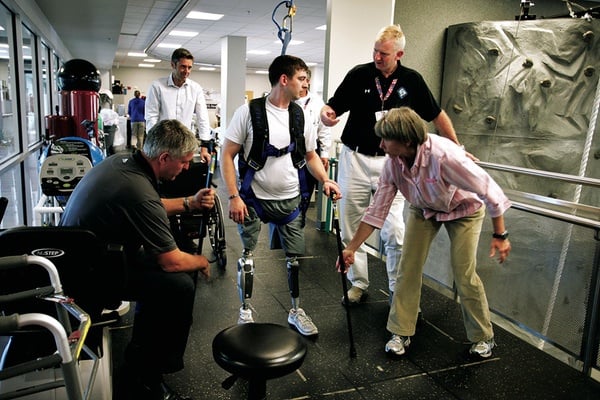
Berschinski, tethered to an overhead track for support, walks on his prosthetic legs at the Walter Reed rehab unit as technicians make adjustments to smooth out his gait. Photograph by Chris Gavin Jones
Medics reached him and attached a tourniquet to what was left of his left leg. Experiencing a strange sense of peace, Berschinski closed his eyes until a sergeant came up to him and said: “Open your eyes, Two-Six”—Berschinski’s call sign.
“I thought if I closed my eyes I would die, and I didn’t want to live because I knew I’d lost my legs,” Berschinski says.
“Thinking I would die didn’t scare me. Soldiers think about these things and try to prepare for them. I didn’t have a wife or children like a lot of my soldiers, and while I love my life, I thought, ‘If this is my time, then this is my time.’ Then I thought of my parents and how distraught they’d be if I died here, so I opened my eyes again to give the medics a chance to save me. We had three medics on the ground, and that’s why I survived.”
Berschinski later learned that an adobe wall around the orchard had possibly saved his life. Being slammed into the wall by the blast is what likely broke his arm and jaw, but it prevented him from being hurled so far away that he couldn’t be found that night. If that had happened, he
would have bled to death.
Medics sent him by helicopter to the Kandahar Airfield. From there he was flown to the military hospital in Landstuhl, Germany, and then to Washington and Walter Reed Army Medical Center. He arrived in DC on August 25, 2009, one week after the explosion.
Berschinski spent the next four months on the orthopedic ward at Walter Reed and has been an outpatient since. His left arm remained immobilized for weeks. Despite being hit by two explosions in the same day, he suffered no serious brain damage.
“My wounds are healed now and I don’t suffer chronic pain, and I’m thankful for that,” he says. “I drive a car and I go to my job two days a week in Arlington.” He has an internship with a Defense Department program called the Joint IED Defeat Organization. “I’ve been to South Africa for the World Cup and I’ve pretty much figured out my new life, and I hope these new legs will continue to open up opportunities for me.”
After months of rehab, he’s gained confidence but knows there’s still a long way to go.
“I’m aware that if I lose my concentration and lean backwards a little bit, it’s game over because I can’t step back to regain my balance. On normal legs, you can walk and talk and chew bubblegum at the same time. But you probably can’t do all three on prosthetics. You have to focus on walking because if you fall down with robot legs, how do you get up?”
He now walks with two canes to help with balance but believes long-term he’ll need only one to give him extra stability and allow him to rest while standing.
He’s been inspired by a civilian in Seattle who was run over by a train and suffered the same leg loss. A daily walker who uses just one cane, he sent Berschinski a video of himself.
“He is really inspirational for me,” Berschinski says, “because I had thought I would always need two canes. I realize in some ways a wheelchair might be more practical for me, but I can deal with some impracticality to be able to stand up and look people in the eye.”
Berschinski wants to pursue an MBA degree. His girlfriend is also interested in getting her MBA, and they hope to go to graduate school together.
“Although I’ve grown more comfortable with my situation,” he says, “I still have my dark days. Sometimes I wake up in the morning thinking all I have to do is stand up—until I’m snapped back to reality. But I have to accept that this is what I am now and work through it because I know no amount of tears or self-pity is going to give me my old life back.
“I can still do a lot of things in life. I can enjoy many things and I can still help people, and if I had died in that orchard in Afghanistan I couldn’t do that, so I’m thankful I survived.”
Next: Dawn Halfaker dreams of having two arms

DAWN HALFAKER
Once a basketball star, she dreams of having two arms
✯ ✯ ✯ ✯
Lieutenant Dawn Halfaker remembers seeing a flash of light, hearing an explosion, and yelling at the Humvee driver: “Get us out of the kill zone! Get back to the police station!” After barely making it to the station, she felt pain in her arm and heard her badly wounded squad leader saying, “Tell my kids I love them.”
When she awoke from a 12-day induced coma and looked up to see her mother and father, she wondered how they had gotten to Iraq. When her parents told her she was at DC’s Walter Reed Army Medical Center, she realized she had been hurt.
“My arm is going to be fine,” she told them.
“I’m sorry,” her father said. “They had to cut it off.”
She looked and saw white bandages where her right arm had been.
Halfaker had suffered other injuries when a rocket-propelled grenade slammed into the armored Humvee she was in at around 3 am that night in July 2004. It shot through the front of the vehicle and exploded in the rear where Halfaker was, shattering her shoulder blade, breaking five ribs, burning her face and hair, and partially deafening her. Damage to her lung triggered a near-fatal infection.
“I’d never been ill in my life, and I was having a lot of difficulty accepting the reality of what had happened to me,” she says. “I kept wanting to know when I could go back with my platoon. When I did accept the fact of my injury, I told my mother I could not bear to see myself with my arm missing and asked her to cover up the mirrors in my hospital room.”
The daughter of two teachers, Halfaker had been a standout high-school basketball player in her native San Diego. Offered several college scholarships to play, she accepted an appointment from the US Military Academy at West Point.
A five-foot-eight guard and four-year starter, she was an outstanding player for West Point. The year before she went, the women’s basketball team had won one game. She helped the team to a five-win season her freshman year and a 19–10 record her senior year, when she was the team’s assist leader and one of its top scorers and defensive players. On graduation, she joined the military police. After a year in Korea, she was deployed to Iraq to help train Iraqis in police work. She had been working in a provincial police station when she was ambushed.
Missing her dominant arm and hand, she struggled through the stages of grief over the lost limb—denial, anger, acceptance.
“I finally worked up the courage to look in the mirror and saw my face had been burned and saw how gaunt I appeared because I had lost a lot of weight.” Clumps of her hair had fallen out. “It was difficult to see myself like that, and I took great comfort from friends and family and from the other soldiers at Walter Reed who had lost limbs. It made me feel that I wasn’t alone in this.
“When I began my rehabilitation, I went to the exercise area for physical therapy and saw a number of amputees, some younger than me, working hard to adjust to their new lives. I noticed a sergeant working with his prosthetic legs. His wife and children were cheering him on. I really admired their spirit and courage, and I drew inspiration from them that continues to this day.”
Halfaker stayed at Walter Reed until May 2005. The hospital became a kind of cocoon, a world of wounded soldiers with shared experiences—a safe place where amputees were viewed as normal.
“I knew I needed to get out and get away from Walter Reed,” she says. “Representative Duncan Hunter was my congressman from San Diego, and he invited me to come to his office and work with him. I took him up on it before I had my prosthetic, so I was going to the Hill twice a week as an intern doing legislative support, research, and correspondence, whatever was needed.” She also did some work with the House Armed Services Committee, which Hunter chaired at the time.
“He was great. He took me under his wing, and now his son, Duncan Hunter Jr., is the congressman from that district. Working in his office pushed me out of my comfort zone in the hospital. I’ve seen veterans who I call ‘professional wounded warriors,’ and I didn’t want to live my life like that. I wanted to get out and do something and resume my life and wear normal clothes.”
Halfaker had to overcome some psychological barriers to reenter the world.
“At first I didn’t want to leave the hospital. The biggest hurdle was that I felt self-conscious about my missing arm. On the subway I could feel people staring at me. Every time I walked down the hall, every time I spoke with someone, I thought, ‘They’re thinking that I look like a freak.’ Now, I don’t believe everyone was staring at me. But that was the mindset I had to overcome.”
In the months after her amputation, Halfaker experienced a lot of phantom-limb pain in her missing arm. She took medications to ease the pain but found the side effects worse than the pain because the pills affected her short-term memory. “I just pushed through it,” she says, “and it’s less of a problem now.”

Halfaker’s arm was sheared off at the shoulder, leaving not enough flesh or bone to attach a usable prosthetic arm easily. She ultimately said no to an aesthetic arm, overcame her self-consciousness about the missing arm, and started a company in Arlington. Photograph by Chris Gavin Jones
Halfaker faced another obstacle. Because her arm had been sheared off at the shoulder, it was difficult to attach a usable prosthetic arm to so little flesh and bone. She was outfitted with a more functional prosthesis that she strapped on over her shoulders every morning. But prosthetic limbs have their limitations.
“The new arm feels like it weighs a thousand pounds, and it doesn’t work that well for me, so I had very limited use of it. It was awkward and uncomfortable.”
In time, an aesthetic arm was made for her and painted by artists to resemble her skin color, including freckles.
“It looked just like my normal arm,” she says. “I wanted to appear as normal as I could, so I wore it everywhere after I left Walter Reed. But I couldn’t use the arm. It just hung there, so I couldn’t shake hands when someone offered me theirs, and I couldn’t extend it or open a door with it. It was attached to me with adhesive, and it became painful to wear and caused neck cramps.”
In the end, Halfaker decided that the prosthetic arm was more trouble than it was worth—more than having a missing arm. So she decided to go about her life with one arm.
Halfaker hopes things might change as prosthetic technology progresses. There have been important advances, including electric elbows, hands, and wrists as well as microcomputers that allow greater function. But researchers have yet to perfect locking devices to attach prosthetic arms at the shoulder that also allow significant movement and control. And because the loss of an arm at the shoulder isn’t very common, less research has been devoted to this challenge than to other prosthetic devices.
“They are working on new arms that will be more functional,” Halfaker says. “I’m open to that, but I’ve become so adapted to using one arm I’m not sure I want to take the time to train myself to use a prosthetic arm. But I’m also faced with the fact that if I overuse my good arm, will I do it harm that will cause me problems when I’m older? Right now I don’t have an answer.”
Halfaker says she has experienced nightmares but is uncomfortable with a diagnosis of posttraumatic stress disorder (PTSD).
“I experienced firefights before I was injured, and there is no question I went through an adjustment period when I left the combat zone and returned home,” she says. “I think all servicepeople over there probably have a similar experience. I dealt with nightmares, most of them unrelated to my injury. I did have dreams that I was being chased, and I would wake up exhausted, sweating, my heart racing. But most of my dreams were not directly related to my experiences there.
“I also suffered panic attacks. The first time I had one, my heart suddenly began racing and I thought I was dying. I’ve since learned how to deal with them. My nightmares have receded, but every now and then I will have one that relates to my Iraq experience.”
After her time in the congressional office, Halfaker became a technical consultant with the Defense Advance Research Projects Agency and settled in the Washington area. In 2006 she started her own national-security consulting company. Called Halfaker and Associates, the Arlington-based firm is involved in security policy, physical security, emergency-management services at military bases, and technical support and training.
Sometimes at night, Halfaker dreams that she has both arms. Now 32, she wants to marry and have children some day; she worries about how she’ll carry a baby and do the other routine tasks of motherhood with one arm.
“Thinking about this forces me to disregard how I look and push myself. I’ve grown stronger in my ability to put myself out there and not let what happened dictate what I will or will not do in my life. A lot of my training at West Point put me in situations in which I was underresourced and overtasked. It teaches you how to compensate and meet your objective despite the circumstances you face. I apply that training to my life now and take it as it comes.”
Next: Life after dying twice and losing an arm and a leg
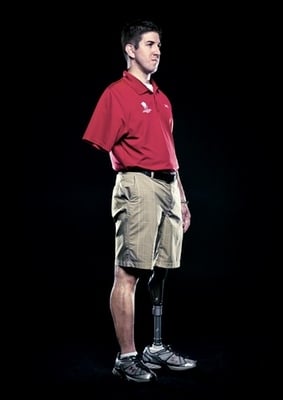
Ryan Kules
He lost an arm and a leg, died twice—and counts himself lucky
✯ ✯ ✯ ✯
The men in Lieutenant Ryan Kules’s Army platoon found his right arm and left leg before they found him—100 feet from the wreckage of the armored Humvee—lying in a canal of cold water, still conscious and trying to stand up 20 minutes after an IED planted in a dirt road exploded under the vehicle. Two soldiers riding with him were killed.
Medics applied tourniquets to stanch the bleeding from what was left of Kules’s two severed limbs. He also had a broken left arm and right ankle, so he had no real use of any of his four limbs. It happened on the morning of November 29, 2005, near Taji, a rural area north of Baghdad, as Kules and his men were returning to base. The three Humvees in the convoy traveled far enough apart that the IED damaged only Kules’s lead Humvee.
“I rode in the lead because part of being a leader is to put yourself in the front,” he says.
An Arizona native and a graduate of Arizona State University, where he was in the Reserve Officers’ Training Corps, Kules has no memory of the incident. He learned what happened from others. Medics at the scene applied “quick clot” to cauterize his bleeding blood vessels. Kules believes he wouldn’t have survived the same injuries in the first Gulf war because quick-clot wasn’t available then.
After he was stabilized, Kules was flown to Kuwait and then to the military hospital in Landstuhl, where his parents and his wife, Nancy—a kindergarten teacher in Arizona—met him. Ryan and Nancy had met when they worked at Costco and got married before Kules deployed to Iraq.
When Nancy and Kules’s parents arrived at the hospital, they found him wrapped in bandages. The only visible parts of him were his forehead, a toe, and his ears, which were caked with dried blood. Doctors told Nancy that in addition to losing two limbs, Kules had suffered brain bleeding. Given both factors, the doctors weren’t sure he’d live.
In an e-mail to friends and relatives, Nancy wrote: “I want my Ryan back (past, present and future) and all those memories that we share and I have been reliving for the past few days. . . . I have faith that this will happen.”
It almost didn’t. In Kuwait and again at Walter Reed, Kules went into cardiac arrest and had no observable pulse until he was resuscitated. “I died twice,” he says.
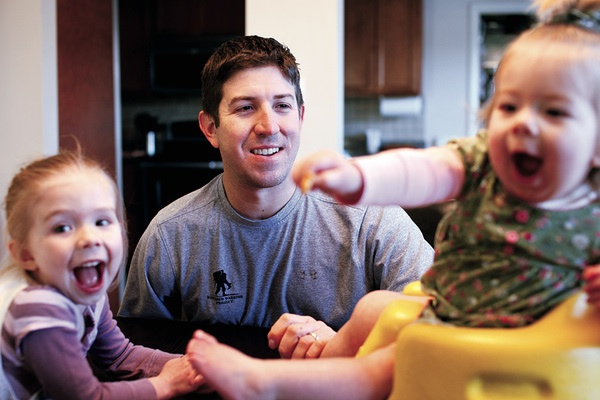
Kules plays with daughters Jillian, four, and Liv, two, at home in Bowie. Photograph by Chris Gavin Jones
Kules, 25 at the time of his injury, also developed a high fever and was comatose for several days. About two weeks after his injury, he spoke for the first time to his father, the only person in the room with him at the time.
Later he greeted his wife. “Hi, Nancy,” he said. She asked if he could remember his dog’s name. “Peanut,” he said.
Kules underwent three dozen surgeries, remained an inpatient at Walter Reed for four months, and went twice a week for 14 months as an outpatient. Nancy lived at Fisher House on the Walter Reed campus while Kules was an inpatient, and the couple stayed there when he became an outpatient. (The Fisher House Foundation provides housing for family of hospitalized servicemembers at military hospitals around the country.) Kules’s brain injury has left him with mild short-term-memory loss and occasional headaches.
“When I was sitting at home a year after the incident, posttraumatic stress disorder hit me and suddenly Iraq became very real again,” he says. “I knew my limbs were never coming back, and I kept thinking that I had lost my guys, that I had been their platoon leader, and I felt a tremendous amount of guilt and blamed myself for it. I kept questioning the decisions I made leading up to the attack. I began to withdraw, and I wanted to be alone.
“My company commander lived in Virginia, and he helped motivate me and change the way I was feeling. He helped me understand that what happened was not my fault, that it was part of war and beyond my control.”
Kules says that even though his guilt has subsided, “I think about those guys every day of my life. I can see now there was nothing I could have done to change the situation and nothing I can do about it now. I’ve become friends with the father of one of the guys, and I’m in touch with him on Facebook.
“I still have some aspect of PTSD, as I think so many veterans do who served in Iraq and Afghanistan. I think everyone who suffers from it has different triggers that bring you back there. For me, I become startled every time there’s an unexpected noise.”
Like Dawn Halfaker’s, Kules’s right arm was torn off at the shoulder and prosthetic arms proved too cumbersome. “I finally gave up on it because it didn’t work very well for me, and there’s nothing yet that looks like it will work for me. I learned how to write left-handed and fully use my left hand and arm quickly because I had no other choice.”
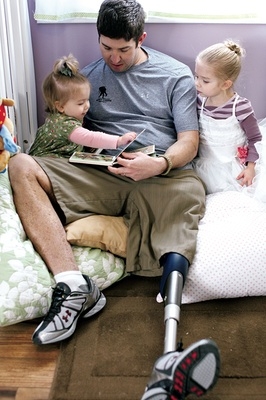
He lost his left leg above the knee but still had about three inches of the femur, the body’s largest bone. That was enough to attach a prosthetic leg to—in Kules’s case a C-Leg, the first computer-controlled stance-and-swing-phase prosthetic knee that monitors and adapts to the patient’s gait.
The C-Leg, developed by the German company Otto Bock, isn’t a powered prosthesis but has microsensors in the knee and shin that monitor and detect terrain changes up to 50 times a second. So if Kules comes upon a stone or sudden alterations in the ground level that might cause a stumble, the C-Leg locks and prevents Kules from falling. This allows Kules to speed up or slow down, climb stairs, or walk on uneven pavement with far more freedom of movement. Kules also uses the leg to play golf.
It took Kules six months to get accustomed to the leg and use it to walk around. He uses neither a cane nor a wheelchair. He can drive a car—he and Nancy have taken road trips across the country. He leads a more vigorous life than many able-bodied people do, having gone waterskiing, whitewater rafting, biking, fishing, and canoeing.
Kules was promoted to captain in July 2006, two months after his and Nancy’s first daughter, Jillian, was born; their second daughter, Liv, arrived in August 2009. A son, Evan, was born in June of this year.
“I had to figure out how to change diapers with one arm,” Kules says, “because my wife wouldn’t let me use the one arm as an excuse. I also had to figure out a safe way to carry my daughters around. It made me realize the best rehab is life itself, learning how to do things you need to do.
“The thing I struggle with a lot is that I like to run. I ran in high school and have always enjoyed it. I have another prosthetic running leg that I put on when I want to run. It has a kind of ‘J’ shape, the kind you see runners using in Paralympics, and it does allow me to move at a pretty good pace.”
Like virtually everyone who has lost a limb, Kules had to overcome his self-consciousness once he left Walter Reed.
“I see kids sometimes point me out and say, ‘Look at that guy.’ In the beginning it was hard to deal with, so I had to learn to accept it because it’s never going away.
“People assume you go to the hospital and get better, and to a certain extent that’s true. But I don’t think they fully understand that what happens to us remains with us forever. Our limbs don’t grow back, and we are never the same person. It is always with us, and we have to find a way to live our lives as fully as we can in spite of what happened to us.”
Kules, 30, is director of alumni in the Washington office of the Wounded Warrior Project, a nonprofit, nonpartisan organization founded in Roanoke, Virginia, by a group of veterans and friends. It’s currently headquartered in Jacksonville, Florida, with offices in Washington and New York City.
“There are thousands in the military far worse off than I am,” Kules says, “and thousands who did not come back from Iraq or Afghanistan. I may have come back a little dinged up, but I survived and I’m able to experience life. I have a family and a beautiful wife, so I think of myself as being incredibly lucky.”
This article appears in the August 2011 issue of The Washingtonian.

